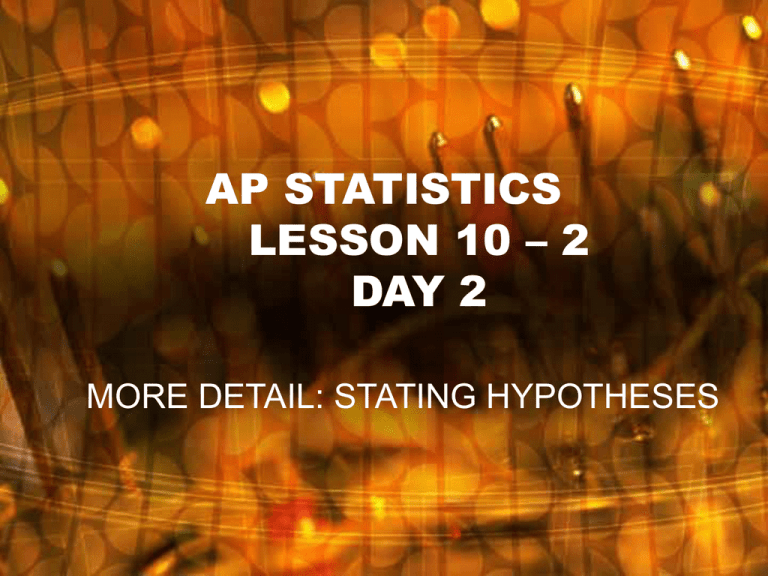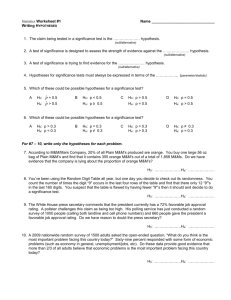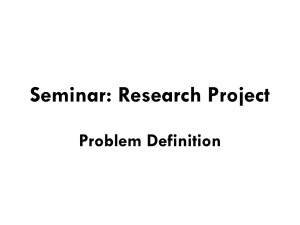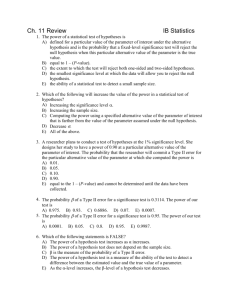10-2 Day 2
advertisement

AP STATISTICS LESSON 10 – 2 DAY 2 MORE DETAIL: STATING HYPOTHESES ESSENTIAL QUESTION: How are hypotheses created and what procedures are different in one-sided and two sided tests? Objectives: • To create hypotheses for significance tests. • To do the calculations involved with onesided and two-sided significance tests. More Detail: Stating Hypotheses • The first step in a test of significance is to state a claim that we will try to find evidence against. This claim is our null hypotheses. • The alternative hypotheses, Ha is the claim about the population that we are truing to find evidence for. Null Hypotheses Ho • The statement being tested in a test of significance is called the null hypotheses. • The test of significance is designed to asses the strength of the evidence against the null hypotheses. Usually the null hypotheses is a statement of “no effect” or “ no difference.” One-sided and Two Sided Hypotheses Ho : μ = 0 H a: μ > 0 This alternative hypotheses is one-sided. Ho: μ = 0 H a: μ ≠ 0 The direction is not specified so it is a two sided hypotheses. Example 10.10 Page 565 Studying Job Satisfaction Does the job satisfaction of assembly workers differ when their work is machine-paced rather than selfpaced? One study chose 28 subjects at random from a group of women who worked at assembling electronic devices. Half of the subjects were assigned at random to each of two groups. Both groups did similar assembly work, but one work setup allowed workers to pace themselves and the other featured an assembly line that at a fixed time intervals so that the workers were paced by machine. One-sided vs. Two-sided • Always state Ho and Ha in terms of population parameters. • It is not always easy to decide whether Ha should be one-sided or two sided. In the case of Example 10.10 all that is stated is that there is a difference. • If you do not have a specific direction firmly in mind in advance, use a two-sided alternative. More detail: P-values and Statistical Significance • A test of significance assess the evidence against the null hypotheses by giving a probability, the P-value. • If the sample statistic falls far from the value of the population parameter suggested by the null hypotheses in the direction specified by the alternative hypotheses, it is good evidence against Ho in favor of Ha. P-value The probability, computed assuming that Ho is true, that the observed outcome would take a value as extreme or more extreme than that actually observed is called the P-value of the test. The smaller the P-value is, the stronger is the evidence against Ho provided by the data. Final step in Assessing Significance Tests We can compare the P-value with a fixed value that we regard as decisive. This amounts to announcing in advance how much evidence against Ho we will insist on. The decisive value of P is called the significance level. We write it as α, the Greek letter alpha. If we choose α = .05, we are requiring that the data give evidence against Ho so strong that it would happen no more than 5% of the time. If α = .01, we are insisting on stronger evidence against Ho that we insist on evidence so strong it only happens 1% of the time. Statistical significance • If the P-value is a small or smaller than alpha, we say that the data are statistically significant at level α. • “Significant” in the statistical sense does not mean “important.” It means simply “not likely to happen just by chance.” The significance level α makes “not likely” more exact. • Significance level 0.01 is often expressed by the statement” “The results were significant (P < 0.01)”









